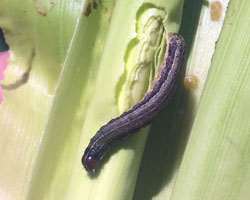By Chloe Creager

As corn and alfalfa crops continue to grow, K-State Research and Extension crop specialists are observing different pests currently in Kansas. Challenges impacting the crops include potato leafhoppers, green cloverworms, fall armyworms and corn rootworms, according to Kansas State University associate professor of entomology and pest management extension specialist Jeff Whitworth.
Alfalfa
Potato leafhoppers have been observed in north-central and south-central Kansas since May, about a month earlier than the pests would normally be seen, Whitworth said.
Potato leafhoppers usually don’t spend the winter in Kansas and will migrate back between the first and second alfalfa cutting, but this year they’ve been present since before the first cutting, he said. Early mild and later cool temperatures throughout the winter and spring played a role in the difference.
The insects will suck juices out of the plants, and while the adults don’t do much damage, excessive heat and moisture removal add to plant stress. As of May, all of the observed potato leafhoppers were adults, and weekly samples have not yet indicated that there are any nymphs.
“Mainly, they’re mating and laying eggs in the stem of the plant,” Whitworth said. “It’s the nymphs – once they start hatching out – that start sucking the juice out of the plant, so when you get additional fluid removal that just adds to the stress level of alfalfa.”
Another risk from these pests is that they can transmit hopper burn, which manifests with a yellowing around leaves. It can move to the stem if the insects feed long enough and can kill the crop if left untreated.
Whitworth recommends swathing alfalfa to help control the population. The pests will continue to migrate in, he said, but swathing will help control the first infestation, and they won’t feed on the cut product.
If producers decide to treat their crops, there are many insecticides labeled for use with potato leafhopper control. Whitworth said growers could probably use the lowest rate with the cheapest material and have good control of the pest.
If producers treat alfalfa, he said, they should check reemerging plant tissue and stubble weekly to make sure more potato leafhoppers aren’t present, because they have a low economic injury level. EIL is the smallest number of insects (amount of injury) that will cause yield losses equal to the insect management costs.
Green cloverworms have also been observed in alfalfa, according to Whitworth.
These insects may not be as risky from an alfalfa producer’s perspective, but they could become problematic as they mature and fly out of alfalfa into soybean fields. Since most soybean crops are recently planted or emerging and worms are in final larval stages, they will pupate, and the moths will likely fly to soybeans that they can defoliate.
“A young vegetative soybean plant can withstand 40 to 60 percent defoliation under good growing conditions before it’s going to impact yield as long as it gets cleaned up,” Whitworth said. There are a number of insecticides that are effective for controlling green cloverworms or bean leaf beetles once you’ve hit the 30 to 40 percent defoliation threshold and decide you need to treat.
Corn
Producers are starting to see fall armyworms feeding in corn; they are maturing and will be pupating soon, Whitworth said. As plants develop into the whorl stage, ragworms will probably eat leaves as they grow and leave them ragged-looking, but he does not recommend treatment for whorl-stage worms.
“Yes, it’s visual and gets everybody’s attention, and yes, it does cause concern; but we’ve done several studies over the years,” he said. “No. 1, it doesn’t cause any yield reduction; the plants grow out of it. No. 2, even if you do treat you can’t get the insecticide down into the base of the whorl where the worms are, so you can’t kill them until they’re through feeding and crawl out anyway.”
If 70 to 80 percent of plants are infested and the worms inside the whorls are small, it could be beneficial to treat them, but usually by the time the grower notices it, the worms are already mature. Whitworth said he has only seen this once, however, and generally does not recommend treating whorl-stage leaf-eating damage in corn.
Adult tarnished plant bugs have been found in corn throughout north-central and south-central Kansas. These insects are not a pest of corn; however, they can suck the juices out of developing seeds in sorghum if there are enough of them in the head and can produce problems with seeding alfalfa. They look similar to adult western corn rootworms.
“Last year, we got a lot of calls about these tarnished plant bugs in silks because the corn rootworms will clip them, and a lot of growers were worried that’s what was going to happen,” Whitworth said. “Make sure to get a positive identification when it comes to silking time in your corn to make sure it’s not corn rootworm; make sure it is a tarnished plant bug, because they will not cause any problems in the corn except confusion.”
According to the June 23 K-State Insect Diagnostic Laboratory Report, the first western corn rootworm adults were collected on June 17 in north-central Kansas, and there are still some larvae feeding on roots. None of the sampled plants had begun tasseling, so the adults are still feeding on leaves and will not impact yield.
Source:k-state.edu